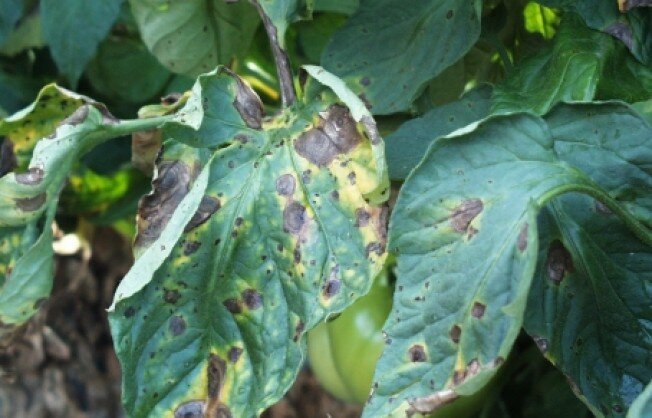The Fungus Among Us - Blight
BLIGHT…a word that strikes fear in the hearts of even the most seasoned gardeners. The last two years have seen some of the worst blight seasons I can remember.
Early Blight on tomato leaf
I’m going to go back in time here and refer back to a posting on my Home Grown Edible Landscapes Facebook page (http://www.facebook.com/myhgel) that I put up the summer of 2009 about the rampant blight that was being seen in home gardens on the east coast which was thought to have been released on transplants sold in retail stores. (SEE HGEL POST FROM JULY 19, 2009). That, coupled with the VERY wonky 2009 summer (cool, rainy then humid) that they had back east and you have a perfect breeding ground for the spread of this fungi. 2021’s growing season, at least here in the Los Angeles area, hasn’t been much better but with a little strategy, weather forecast geek-out and a tool kit with just the right organic fungicides…YOU’LL BE READY!
This posting will address this ubiquitous fungal-like pathogen that plagues all plants in the Solanaceae family (potatoes, tomatoes, eggplant, sweet peppers, chili peppers, tobacco and petunias): BLIGHT.
Let’s start from the beginning….WHAT IS BLIGHT?
Early Blight on tomato
Early Blight (Alternaria solani)
This is a fungal disease that effects leaves, stems and fruit of the tomato plant. Early Blight happens quickly under warm, humid conditions. Plants that are stressed by nitrogen deficiency, over-head irrigation or heavy fruit production can make plants vulnerable to the disease. Leaf lesions will appear on older leaves first with round spots of about 1/2 inch in diameter resembling a “target-like” pattern surrounded by a yellowing area. On the fruit the lesions look dry and are seen most often on the stem end of the fruit with the same “target-like” pattern. Lesions on the stems are seen on older plants and are usually seen on only one side of the stem.
Septoria leaf spot
Septoria is another fungal disease, like early blight, that can cause leaves to turn brown and die. It does not effect fruit. Leaf lesions will show up as yellow areas first that later become round with gray centers and dark borders.
Late blight
Late blight on tomato leaf
This is a very destructive and very infectious disease that is significant in potatoes (not sweet potato) but also occurs in tomatoes. It is the same disease that lead to the Irish Potato Famine in the 1840s. It is caused by the fungal-like pathogen, Phytophthora infestans that survives from one season to the next in infected potato tubers and tomato transplants as well as dead potato and tomato vines. This organism is well known for its ability to produce millions of spores from infected plants under unseasonably cool wet weather conditions that favor the disease. All parts of the plant are affected including the fruit which can manifest as greasy, gray spots that spread quickly. Early in the season, the disease can be introduced into a garden on infected seed potatoes, from volunteer plants growing from diseased potatoes that were not harvested last season, compost piles, or infected tomato transplants brought into the area. Temperatures consistently above 86 degrees have been shown to be unfavorable for late blight.
Spores produced on infected potatoes and tomatoes can travel through the air, land on infected plants, and if the weather is consistently moist or wet, cause new infections. Spores can also be washed through the soil to infect potato tubers, which may rot before harvest, or later in storage.
Because the pathogen that causes late blight produces so many spores, and the spores can travel long distances through the air, it is very important that everyone who grows potatoes or tomatoes is able to identify late blight and know how to control it, to avoid being a source of spores that infect potatoes and tomatoes in neighboring gardens.
HOW TO IDENTIFY IT
Late blight on potato
On potato tubers:
Infected potatoes have shallow, brownish or purplish lesions on the surface of the tuber. If you cut across the surface of these infected areas, you’ll see a reddish-brown, dry, granular rot that extends up to half an inch into the flesh.
Late blight on potato stems
On potato plants:
Late blight lesions can occur on both leaves and stems. The first appearance of lesions commonly occurs after periods of wet weather. Black lesions appear within 3-7 days of infection of leaves. Under humid conditions, delicate, whitish growth (pathogen spores) are produced at the edge of the lesion, particularly on the underside of the leaf. Lesions turn brown when they dry up.
On tomatoes:
Late blight on tomato
Symptoms on tomato leaves and stems are similar to those on potato. On tomato fruit, late blight causes a firm, dark, greasy looking lesion from which the pathogen spore producing structures emerge under humid conditions.
HOW TO PREVENT BLIGHT
Make sure you’re routinely adding plenty of organic matter to your soil which is teeming with ‘good’ fungi that can counteract the ‘bad’ fungi. But…if you’ve been gardening with me for awhile, you already do this!
The most effective management strategy for late blight is to avoid sources of early season spores.
CLEAN, CLEAN, CLEAN! Blight, depending on the type, can survive on living or dead plant tissue and in the soil or compost pile for over a year so practice good soil hygiene! Do a thorough end-of-season garden clean up and bag and dispose of any remnants of diseased plants (do not compost!). Thoroughly clean your tools after working on an infected plant and at season end (soak in 9 parts water to 1 part bleach, rinse well and dry completely)! If you are stepping on soil that you suspect might be infected…clean your shoes!
Prune away infected leaves as much as possible without over-pruning. That’s a trick, I know, put if you stick to taking only the worst infected leaves off at any one time and staying within the 30/70 rule (never remove more than 30% of the leafy canopy a week), you should be ok. In concert with routine spraying of the appropriate fungicide (see below) and maintenance pruning, you may find you need to stimulate your plant to generate leafy growth to replace diseased leaves you’ve removed. Side-dress with blood meal and water in thoroughly. In a few weeks you should see the plant responding.
Potato tubers or tomatoes (transplants or imported fruit) are a source of early season spores. One important way to avoid introducing late blight on potatoes is to plant healthy certified seed potatoes. Many states where potato seed is produced have seed certification programs to ensure that the seed meets certain standards for disease levels. Certified seed is not a guarantee that late blight will not be present, however. Examine your seed and your tomato transplants carefully before you buy and plant them. In the case of potatoes, plant only sound, blemish-free tubers.
Planting resistant varieties of potatoes will slow down (but not prevent) blight. Currently, “Defender” and “Elba” are the most resistant varieties available. Potato varieties with moderate levels of resistance include: Kennebec, Sebago, and Allegany. Some resistant tomato varieties are listed in the chart below.
See list below for more tips…
HOW TO TREAT IT
If the growing season is wet, and late blight is present, fungicides will be necessary to protect your plants from infection. For home gardeners the only available fungicides that are effective against blight are protectant materials, which means that they must be on the foliage BEFORE spores land on leaves. Infection only occurs when the leaves are wet. Unfortunately this means that continuous fungicide coverage is needed to protect plants from Blight. TOMATOES AND POTATOES ARE OPEN TO BLIGHT INFECTION ANY TIME OF THE GROWING SEASON DEPENDING ON THE CONDITIONS SO FREQUENT GARDEN CHECKS ARE A MUST! Hey, you’re out there any way, right?
Commercial fungicides are available that have maneb, mancozeb, chlorothalonil as their active ingredient but they are not organic. Organic gardeners should look for OMRI Listed fungicides that specifically state late blight as one of the fungi they control. These include Bonide® Liquid Copper Fungicide, Cueva Copper Soap Fungicide, as well as others. READ AND FOLLOW LABEL INSTRUCTIONS CAREFULLY! If you are using a copper fungicide be aware that excessive use can result in the buildup of copper to phytotoxic (crop damaging) levels in the soil. Because of this, professional organic growers monitor soil copper levels through regular soil testing.
If you choose not to use fungicide, AGAIN, it is crucial that you frequently check your plants ESPECIALLY DURING CONDUCIVE WEATHER PATTERNS and remove and destroy infected plants to avoid spreading the disease. If possible, destroy infected plants on a dry, sunny day (not too much wind either) when dislodged spores will die quickly. If the weather is continuously wet, it is better to destroy plants sooner rather than waiting for a dry day.
ATTRA’S Integrated Pest Management Guide. Click HERE to download.
Other natural treatments: According to ATTRA , there are several other natural approaches to treating these nasties that look promising. Here’s what they say on the subject:
Several natural remedies may be employed by organic farmers for foliar disease management. These include a wide range of products and practices including: compost watery extracts; hydrogen peroxide; sodium bicarbonate; foliar fertilizers; plant extracts (fermented nettle tea, equisetum tea, comfrey tea); and biostimulants (seaweed, humates). The precise mode of action for many of these materials remains to be discovered.
Of these, compost watery extracts and hydrogen peroxide look promising for the control of tomato diseases like early blight. Compost extracts have proven effective for several vegetable diseases, including late blight of tomatoes.(51) See the ATTRA publication Notes on Compost Teas for references and resources.
Little information is available on the use and efficacy of hydrogen peroxide. Growers in New Jersey are using 35% hydrogen peroxide and diluting it to a 0.5%-1% foliar spray solution, though lower rates are also common. Rates of 2% and 4% are being used as a post-harvest wash. A 1% solution is equivalent to 3.7 oz in 124.3 oz of water, while a 0.5% solution is equivalent to 1.8 oz in 126.2 oz of water.(52)
Biological fungicides are a relatively new tool available to organic growers. Biological fungicides contain beneficial bacteria or fungi (microbial antagonists) which help suppress pathogens that cause plant disease. For example, F-Stop™, registered as a seed treatment for tomatoes, contains a biocontrol agent called Trichoderma viride sensu. T-22G Biological Plant Protectant Granules™, registered as an in-furrow soil treatment on tomatoes and other vegetables, contains Trichoderma harzianum, strain KRL-AG2.
A few words on rock phosphate:
Although it is an accepted amendment in sustainable organic farming, it still is a mined substance and, therefore, in my opinion, has a negative impact to the environment that I’d like to avoid. Also, PR is effective only at a very low (acid) pH ( <5.5) and must be fully dissolved & rendered into a form that is available to plants by certain environmental conditions (good rainfall or irrigation, low solution concentration of Ca ions, low P fertility levels and high organic-matter content). I usually avoid using PRs.
TO AVOID INFECTION FROM POTATO TUBERS:
Hill up soil around the base of potato plants to provide a barrier to spores that can wash through the soil. Vines should be dead 2-3 weeks before digging potatoes for storage.
TEN THINGS YOU CAN DO TO PREVENT TOMATO BLIGHT:
1. Grow tomatoes in a warm, dry, sunny area. If you have had blight previously, move to a different area if possible, or replace the upper soil layer since “oospores” will carryover in soil.
2. Water only underneath the plants, not the leaves or fruit. Drip irrigation is preferable to watering with a hose, to reduce water splash. Don’t over fertilize or over water.
3. Avoid growing in clay soil if possible or cover soil with a white plastic mulch to increase soil and air temperatures around the plants and reduce humidity.
4. Growing plants under an overhang or a clear plastic shelter will help prevent spores from being deposited on plants by wind and rain. But plants must be covered before infection has occured. Covering the plants after they are infected may raise humidity and make the disease worse.
5. Grow the tomatoes on raised beds with well-spaced trellises or in containers off the ground. Tomatoes grown on balconies or roof-tops rarely develop late blight, probably because the environment is warmer and drier.
6. Remove all of last year’s tomato or potato debris to prevent carry over of disease.
7. Remove diseased leaves or shoots immediately and all plants that are severely diseased. Bury them, or seal them in a plastic bag and take to a landfill. Do not compost diseased plants. If “oospores” are present, they will survive in compost as the organism can survive mild winters on small bits of un-rotted or un-frozen plant debris in the soil or compost. So a THOROUGH cleanup between seasons is important. Also critical is CROP ROTATION. Don’t grow crops in the same family in the same area in subsequent seasons.
8. Destroy any volunteer potato or tomato plants in the garden.
9. Destroy any nightshade weeds along fencerows. Nightshade is related to tomato and potato and is also a good host for blight.
10. Use resistant varieties when they become available.
If in doubt whether it is blight, take a sample to a local trusted nursery or Master Gardener for identification.
Here is a handy guide to tomato varieties that resistant to various tomato diseases:
Click HERE to download and print this chart.
Sources:
Cornell University Integrated Pest Management
Bristish Columbia Ministry of Agriculture










